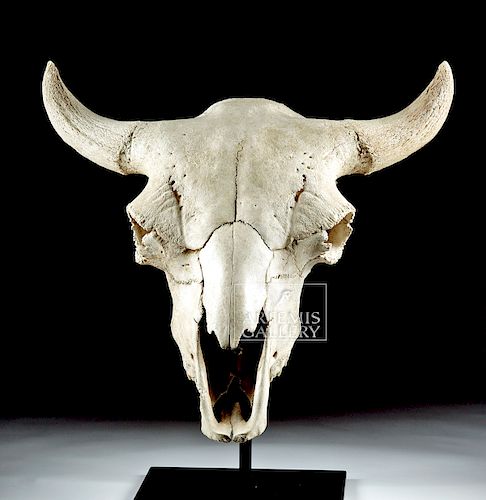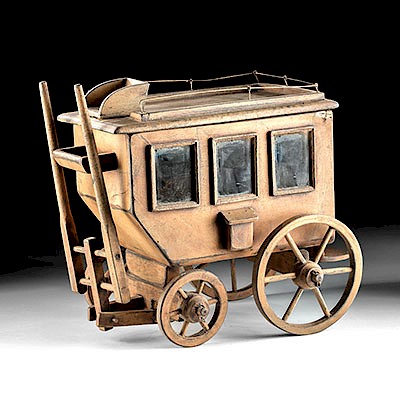Well-Preserved Fossilized American Bison Skull
Lot 10
About Seller
Artemis Fine Arts
686 S Taylor Ave, Ste 106
Louisville, CO 80027
United States
Selling antiquities, ancient and ethnographic art online since 1993, Artemis Gallery specializes in Classical Antiquities (Egyptian, Greek, Roman, Near Eastern), Asian, Pre-Columbian, African / Tribal / Oceanographic art. Our extensive inventory includes pottery, stone, metal, wood, glass and textil...Read more
Estimate:
$3,000 - $5,000
Absentee vs Live bid
Two ways to bid:
- Leave a max absentee bid and the platform will bid on your behalf up to your maximum bid during the live auction.
- Bid live during the auction and your bids will be submitted real-time to the auctioneer.
Bid Increments
| Price | Bid Increment |
|---|---|
| $0 | $25 |
| $300 | $50 |
| $1,000 | $100 |
| $2,000 | $250 |
| $5,000 | $500 |
| $10,000 | $1,000 |
| $20,000 | $2,500 |
| $50,000 | $5,000 |
| $100,000 | $10,000 |
| $200,000 | $20,000 |
About Auction
By Artemis Fine Arts
Nov 14, 2019
Set Reminder
2019-11-14 10:00:00
2019-11-14 10:00:00
America/New_York
Bidsquare
Bidsquare : Ethnographic | Tribal | American Frontier
https://www.bidsquare.com/auctions/artemis-gallery/ethnographic-tribal-american-frontier-4634
Featuring Pre-Columbian, Tribal / Oceanic, Spanish Colonial, historical examples from the Spanish, Mexican, and American frontiers, fossils, and more. All items offered for sale have been legally acquired, are legal to sell and are guaranteed to be as described or your money back. Artemis Fine Arts info@artemisfinearts.com
Featuring Pre-Columbian, Tribal / Oceanic, Spanish Colonial, historical examples from the Spanish, Mexican, and American frontiers, fossils, and more. All items offered for sale have been legally acquired, are legal to sell and are guaranteed to be as described or your money back. Artemis Fine Arts info@artemisfinearts.com
- Lot Description
North America, ca. 5000 to 2000 years ago. A well-preserved, fossilized skull of the American bison (Bison bison), also known as an American buffalo, the most iconic animal of the American West, with a wide, heavy face, prominent eye sockets, and curved horns that project horizontally from the sides of the head. The teeth from the upper jaw are well preserved. The bovine family, which contains Taurids (cattle) and bisonids, diverged from a common ancestor with the water buffalo and African buffalo around 5 to 10 million years ago. The bison at some point migrated from the Old World into the New. During the Ice Age, they were much larger, with species like Bison latifrons (giant bison) and Bison antiquus evolving to become smaller and smaller as the millennia passed and the climate changed. That does not mean they are small animals in our non-Ice Age times - in fact, today, they are the largest land mammal in North America - bigger than moose, elk, and even grizzly bears! Adult males can weigh up to 2000 pounds and stand six feet tall. Size: 24" W x 23.75" H (61 cm x 60.3 cm); 25.5" H (64.8 cm) on included custom stand.
Provenance: private Hawaii, USA collection; ex-private Hawaii, USA collection
All items legal to buy/sell under U.S. Statute covering cultural patrimony Code 2600, CHAPTER 14, and are guaranteed to be as described or your money back.
A Certificate of Authenticity will accompany all winning bids.
We ship worldwide and handle all shipping in-house for your convenience.
#143419Surface is bleached from open air contact. Near complete with no repairs, some small areas of loss low on the nasal cavity. Lower jaw is not present.Condition
- Shipping Info
-
All shipping is handled in-house for your convenience. Your invoice from Artemis Gallery will include shipping calculation instructions. If in doubt, please inquire BEFORE bidding for estimated shipping costs for individual items.
-
- Buyer's Premium



 EUR
EUR CAD
CAD AUD
AUD GBP
GBP MXN
MXN HKD
HKD CNY
CNY MYR
MYR SEK
SEK SGD
SGD CHF
CHF THB
THB














